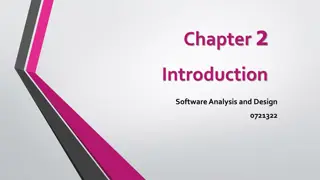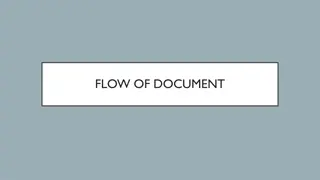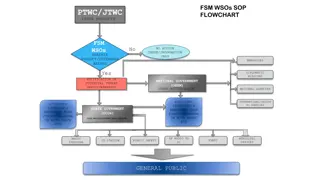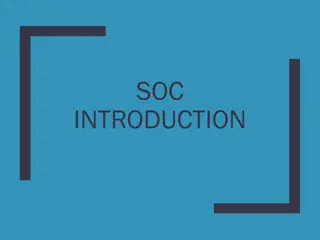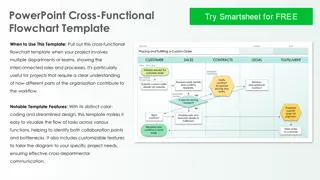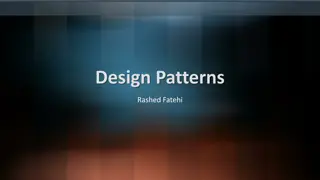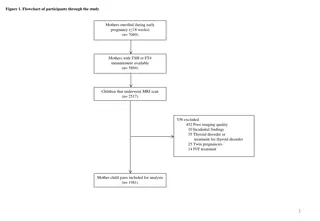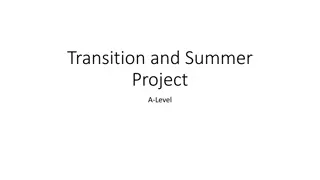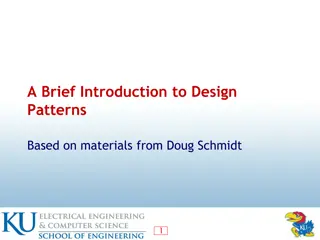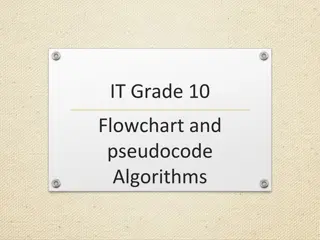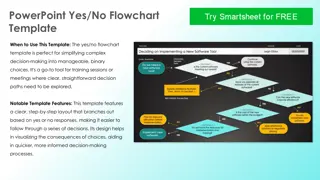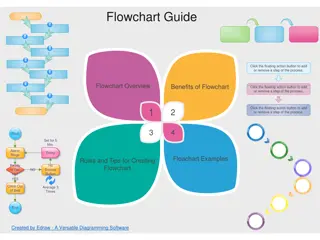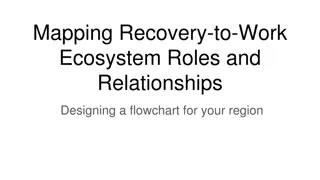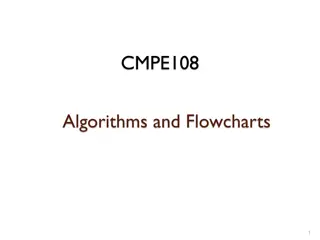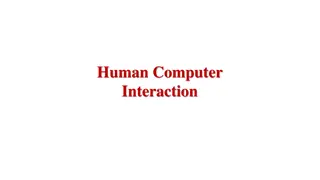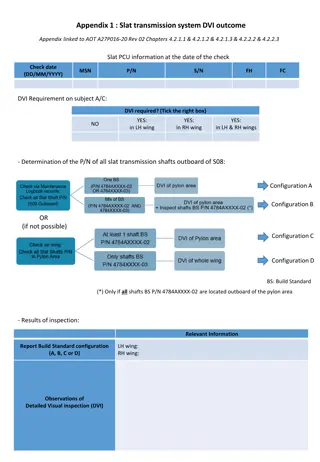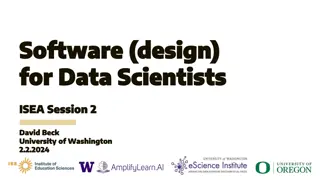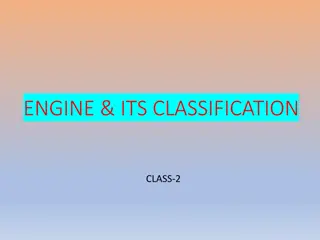GCSE Design Technology Knowledge Organiser and Course Structure Overview
In this detailed knowledge organiser, find information about the GCSE Design Technology course structure, learning objectives, mission statement, and core technical principles for KS4 students. The course emphasizes iterative design cycles, creative thinking, problem-solving, and addressing environm
7 views • 53 slides
Software Analysis and Design Process
Software analysis and design involve a systematic approach to understanding user requirements, creating logical models, and transitioning to detailed design specifications. Requirements analysis focuses on capturing system requirements, while design translates these requirements into implementation
8 views • 16 slides
Flowcharts for Document Management
Flowcharts are visual representations that depict the logical flow of processes within a system or program. They serve as communication tools and aid in documentation. Flowcharts follow specific guidelines such as top-to-bottom creation starting from the left of a page. Each activity within a flowch
6 views • 21 slides
Textil School for Design, Technology, and Management - Overview
The Textil School for Design, Technology, and Management is a renowned institution funded by the European Union. Offering undergraduate applied studies in Textile and Apparel Design, Textile Engineering, and Management in the Textile Industry, the school focuses on artistic expression, modern method
0 views • 16 slides
TSA Updates on Security Training Rule for OTRB Companies
In the recent updates by TSA, the Security Training Rule for over-the-road bus (OTRB) companies has been highlighted. The rule mandates TSA-approved security training for employees in security-sensitive roles, emphasizing key requirements and elements of security training. Urban areas covered by the
1 views • 18 slides
Rental Unit Eligibility Guide under AB 1482
Determine if your rental unit is subject to the rent cap provision of AB 1482 by following a detailed flowchart including considerations such as local rent control ordinances, age of the unit, ownership structure, subsidies, and exemptions. Make informed decisions regarding rent control regulations
2 views • 20 slides
Guidelines for Design of Cement Concrete Pavement and Interlocking Paver Blocks
This document provides guidelines for designing cement concrete pavements and interlocking paver blocks, covering factors governing design, wheel loads, design period, subgrade characteristics, approximate k values based on CBR values, and the importance of a sub-base below concrete pavements. It em
0 views • 67 slides
Disciplinary Procedures & Updates Presentation on Misconduct
Increase staff awareness on disciplinary procedures and misconduct, share disciplinary statistics, provide examples of disciplinary decisions, distinguish between major and minor misconducts, and explain the disciplinary process flowchart. Understand the importance of discipline in an organization,
0 views • 15 slides
Software Engineering Design Principles and Concepts
The chapter discusses the essential principles and concepts in software design, highlighting the four key design models - data design, architectural design, interface design, and component-level design. It emphasizes the importance of traceability to the analysis model, minimizing the gap between so
2 views • 36 slides
Emergency Response SOP for Typhoon Watch and Warning Scenarios
This article outlines the standard operating procedures (SOP) to be followed by relevant agencies in response to typhoon watch and warning scenarios. It includes a flowchart depicting the steps to be taken at different stages of the situation, discussion questions for planning, and specific details
0 views • 18 slides
Python For Loop and its Applications
The lecture discusses the principles of computing loop structures, focusing on the for loop in Python. It explains the general form of a for loop, its flowchart, and provides an example of computing the average of a series of numbers using a for loop. The session highlights the importance of control
0 views • 19 slides
System on Chip (SoC) Design and Components
Explore the world of System on Chip (SoC) design, components, and working flow. Learn about Intellectual Properties (IP), platform-based design, typical design flows, top-down design approach, and the emerging Electronic System Level (ESL) design flow. Discover the essential components of an SoC, su
0 views • 45 slides
Design Inspiration and Elements in Costume and Fashion Design
Dive into the world of costume and fashion design through a visual journey of finding design inspiration, understanding the design process, emphasizing originality, and exploring different sources of creativity. Discover how technology, art, food, history, architecture, and nature can spark innovati
0 views • 45 slides
Enhancing Piping Design Efficiency with Spec-Driven Technology
Explore how Spec-Driven Piping technology powered by CADACTIVE offers a standardized approach for piping design in Creo Parametric. This innovative extension streamlines design communication, eliminates errors, and improves design efficiency by utilizing a master catalog, automated checking capabili
0 views • 15 slides
Cross-Functional Flowchart Template for Project Collaboration
Template for cross-functional flowcharts used in projects involving multiple departments or teams to visualize interconnected roles and processes. Features color-coding for clarity, customizable design, and effective communication across departments.
0 views • 6 slides
Material Design: Combining Classic Design Principles with Technological Innovation
Material Design is a design language that combines traditional design principles with the possibilities offered by technology and science. It emphasizes visual language, classic design elements, and innovation to create delightful user experiences. The Material Metaphor, Imagery, Typography, Color,
0 views • 34 slides
Comprehensive Guide to System Design Components and Techniques
System design involves the detailed planning and identification of components in an information system, aiming to provide users with a general understanding of the new system. This process includes techniques like flowcharts, prototyping, and component design, covering aspects such as output design,
0 views • 24 slides
Design Patterns: A Comprehensive Overview
Exploring the world of design patterns, this content delves into the essence of design patterns, their application in software design to resolve complexity, and the different types of design patterns - creational, structural, and behavioral. It also showcases examples of popular design patterns such
0 views • 22 slides
eClutch Diagnostic Flowchart for DCD991/DCD996 Drill
This detailed eClutch diagnostic flowchart provides step-by-step instructions for troubleshooting potential customer complaints related to the functionality of the DCD991/DCD996 drill, focusing on clutch modes, motor responses, and sensor checks. It covers functional checks, electrical checks, and e
0 views • 9 slides
ACORP Appendix 9: Documentation of Approved Protocol Departures
Appendix 9 serves to document departures approved by the IACUC for a given protocol, allowing inclusion in semiannual reports. It guides users on identifying departures, using the VA Deviations and Departures flowchart, and provides examples for clarity. Criteria for when to use Appendix 9 are outli
0 views • 12 slides
Basic Concepts in Software Design
Software design involves transforming customer requirements into a form suitable for implementation, with activities categorized into preliminary and detailed design stages. High-level design focuses on module identification and control relationships, while detailed design entails defining data stru
1 views • 24 slides
Maternal Thyroid Hormones and Offspring Brain Development: Study Flow and Findings
This study examined the association between maternal thyroid hormones (TSH and FT4) during early pregnancy and offspring brain morphology. A flowchart illustrates participant enrollment and exclusion, with subsequent MRI analyses on child brain volumes. Results show significant associations between
0 views • 4 slides
3D Design and Critical Analysis in Architecture
Dive into the world of 3D design and critical analysis with a focus on architecture. Discover the stages of design, essential skills for designers, and areas of study in three-dimensional design. Delve into iconic buildings like Frank Lloyd Wright's Falling Water, analyze their key features, and eve
0 views • 9 slides
Design Patterns in Object-Oriented Design
Design patterns in object-oriented design (OOD) are essential templates that codify best practices for solving common problems. They help streamline development by capturing proven design decisions, promoting code reuse, and enhancing system flexibility and modularity. Learn about the core concepts,
0 views • 20 slides
Safeguarding Concerns and Procedures in Youth Custody Services
This presentation addresses safeguarding concerns, referrals, allegations, and complaints in Youth Custody Services. It explains the process for raising concerns, involving external stakeholders, and ensuring the quality of care provided to youth in custody. The background outlines the establishment
0 views • 18 slides
PBIS Expectations and Behavior Flowchart
The PBIS flowchart outlines behavior expectations and interventions for minor and major incidents in a school setting. It covers disrespectful behavior, disruption, defiance, property damage, theft, possession of weapons, and more. The flowchart guides teachers and staff on managing and addressing s
0 views • 6 slides
Algorithms: Flowcharts and Pseudocode in IT Grade 10
Flowcharts and pseudocode are essential tools in programming. A flowchart visually represents algorithms through symbols and shapes, while pseudocode provides a detailed description in natural language. Limiting pseudocode statements to one per line and using proper indentation helps organize progra
0 views • 4 slides
Simplifying Decision-Making with Yes/No Flowchart Template
The Yes/No flowchart template in PowerPoint simplifies complex decision-making by breaking it down into binary choices, making it ideal for training sessions or meetings requiring clear decision paths. Its step-by-step layout visualizes consequences, aiding quicker and informed decision-making. The
0 views • 4 slides
The Power of Flowcharts in Process Management
Flowcharts visually present the flow of data, operations, and sequences in information processing systems. They offer benefits such as visual clarity, efficient communication, improved coordination, problem-solving, and proper documentation. Learn about the major types of flowcharts, flowchart desig
0 views • 13 slides
Designing a Recovery-to-Work Ecosystem Roles and Relationships Flowchart
Design a coordinated team of recovery-to-work champions to support individuals in recovery with services and employment opportunities. Explore methods to identify gaps in services, partners to involve, and ways to strengthen relationships within your region. Create a flowchart to map out the process
0 views • 9 slides
Software Development Methodologies and Algorithm Design
This content discusses the Software Development Method emphasizing requirements specification, analysis, design, implementation, testing, and maintenance. It also covers algorithms, pseudocode, flowcharts, flowchart symbols, and structured programming techniques like sequence, selection, and repetit
0 views • 36 slides
Interaction Design in Human-Computer Interaction
Interaction design focuses on creating interactive products that are easy, effective, and enjoyable to use. It aims to reduce negative user experiences while enhancing positive ones. Designing interactive products requires understanding user activities, interfaces, and device arrangements to support
0 views • 11 slides
SE2811 Software Component Design Overview
This course covers software component design, design patterns, object-oriented design, algorithms, and opportunities for reuse in systems design. It emphasizes the importance of domain-level design and provides insights into solving core problems through reusable classes.
1 views • 21 slides
Analysis of Bunch Lengthening in CEPC for Different Design Parameters
This study explores bunch lengthening in the Circular Electron Positron Collider (CEPC) for various design parameters, analyzing a 54 km design scheme, a 61 km design scheme, and a 100 km design scheme. The analysis includes the theoretical framework used, equations for bunch lengthening, and conclu
1 views • 15 slides
Plain & Reinforced Concrete Structures in Design Engineering
In the design of Plain & Reinforced Concrete structures, various strength design methods such as Ultimate Strength Design (USD) and Allowable Strength Design (ASD) are utilized. These methods involve factors of safety, material strength, load factors, and analysis in the elastic range. Additionally,
0 views • 11 slides
Verilog Adder Examples & Typical IC Design Flow
This comprehensive content delves into Verilog adder examples, typical IC design flow, physical design considerations, and examples of OpenGL ES GPU and ARM hypervisor applications. It covers the fundamentals of digital logic with Verilog design, hardware description language, FPGA prototyping, phys
1 views • 27 slides
Aircraft Transmission System Check Appendices
Collection of appendices linked to aircraft transmission system checks including slat transmission system outcomes, typical transmission shaft damages, TSU condition check values recording, and assessment flowchart.
0 views • 4 slides
The Importance of Software Design for Data Scientists
Today's ISEA Session 2 with David Beck from the University of Washington delves into the critical role of intentional software design for data scientists. The session covers the software design approach, user-centric design stories, use cases, components, testing strategies, and the benefits and dra
1 views • 76 slides
Engine Classification and Design
Engine classification involves categorizing engines based on various factors such as combustion type, number of strokes, cylinder design, and ignition method. Common classifications include external and internal combustion engines, as well as categories based on the design and use of the engine. Add
0 views • 11 slides
Planning a Step-by-Step Explanation Text with Flowchart
Exploring the features of explanation texts and how to structure them effectively using flowcharts. Learn about the key elements such as language style, sequencing, technical vocabulary, diagrams, and time conjunctions. Dive into a creative activity involving the Tellyscope video and practice fillin
0 views • 10 slides

